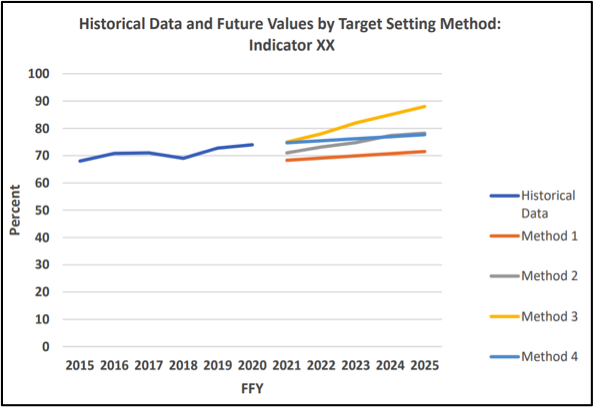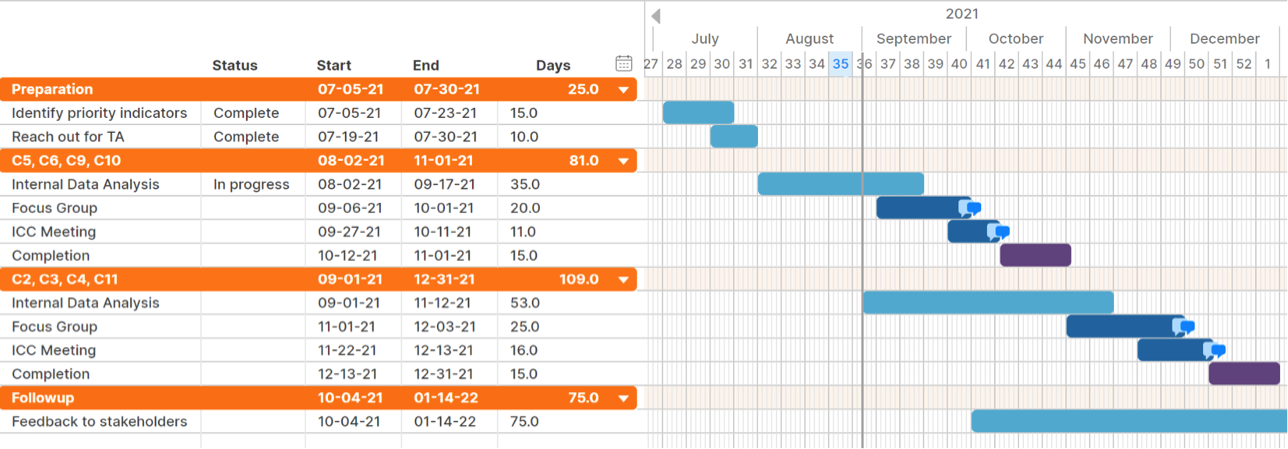A reminder of expectations:
- Targets for compliance indicators are always 100%. This includes indicators C1-Timely Services, C7-45 Day Timelines, C8-Part C Early Childhood Transition, and B12-Early Childhood Transition.
- Targets for all other indicators must show improvement. This includes indicators C2: Settings, C3 and B7: Early Childhood and Preschool Outcomes, C4: Family Outcomes, C5: Child Find Birth to 1, C6: Child Find Birth to 3, B6: Preschool LRE, C9 and C10: Dispute Resolution, C11 and B17: State Systemic Improvement Plan. There are a few exceptions, notably Indicators C2, B6, C9 and C10. See this OSEP guidance document for those details.
Authors: Anne Lucas, Tony Ruggiero, Robin Nelson, Sharon Walsh. Contributor: Margo Smith
If you work in Part C and 619 you know that, this year, every state must set targets for Part C and 619 performance through 2025. These targets must be submitted in the FFY 2020 SPP/APR due February 1, 2022.
States should aim for achievable and rigorous targets. What are achievable and rigorous targets?
- They are challenging without setting the bar out of reach. What does a 0.1% or 0.5% increase look like for your families? How many children and families does that represent?
- They are informed by data, standards, and methods. For example, the “it looks good” method or the “way it has always been done” method are NOT rigorous.
How are states approaching the task?
The process of setting targets takes time. Best practice requires authentic stakeholder engagement and a plan. This begins with a plan across several months to first analyze data for the various indicators, and prepare logistical details for stakeholder input.
- One state team met with TA Center staff in May to get started on their process.
- Another state coordinator focused on looking at their toughest indicator data first and created this timeline:
- Recruitment and inclusion of multiple stakeholders takes intentional planning, and invitation.
- Include parents, personnel, administrators, or others who can provide relevant information, personal experience, or expertise to the proposed work. Federal Requirements
- Will you use an existing group, a focus group or a combination of strategies to gather input? Why or why not?
- Consider if all stakeholders feel confident in discussing the data. What do stakeholders say about their comfort and knowledge with the data? Provide support using the Stakeholder Knowledge Toolkit to shore up participation and process. Intentionally plan activities to increase the capacity of diverse groups of parents.
- Prepare data and proposed targets using charts or graphs for each.
- Bring in context in the data analysis where it make sense. For example, consider initiative(s) that are taking place in the state. When (e.g., month and year) will those initiative(s) take place? Are the initiative(s) taking place statewide? How many children or families will the initiative(s) impact?
- What does your trend data show? Has the state met previous targets? How do data quality issues impact target setting for your state?
- Using multiple methods detailed in the Target Setting Guide and using clear visuals, e.g., potential targets all on one graph, allows stakeholders to see the impact of each. An example:

- Ensure all stakeholders review and discuss the potential targets. Are they too high, too low, or just right?
- Which stakeholders have not shared insights? Without putting them on the spot, find out their thoughts and/or why they haven’t spoken up.
- Does it make sense to maintain stability in targets for a few years? Does it make sense for targets to increase by differing amounts each year? Targets generally must show improvement from the baseline in the end.
- Are targets rigorous, yet achievable? Again, what does a 0.1% or 0.5% increase look like for your families? How many children and families does that represent? Consider including that information visibly and frequently for stakeholders to better understand realistic and achievable targets.
- Considering morale is important in target setting. What quick wins can your state and local agencies get to in the first few years to power momentum for later targets?
- The work is not complete without sharing the results. All participants deserve to hear how their input contributed whether they gave input in a Zoom call, in a survey, or in an ongoing workgroup. Use multiple methods to share results and stakeholder input to all varieties of stakeholders.

(click to view larger version)
Find additional support in the Target Setting Guide
Step #1: Identify and prepare stakeholders with intention and attention to diversity.
– From IDEA Data Center’s Including Stakeholders in Data Meetings
Step #2: Conduct analyses
Step #3: Engage in discussion and seek suggestions.
Step #4: Set targets with stakeholders.
Step #5: Communicate targets and follow up with stakeholders.
Building consensus with stakeholders is difficult and necessary precisely because this is about young children with disabilities and their families. Every piece of data represents a person or family. Keeping this at top of mind helps focus on shared goals when making decisions about achievable and rigorous targets together.
These examples are not the only way to approach this process. Join in the conversation, get support, and share how your state is moving forward with target setting through MyDaSyTA or ask for someone to contact you.
About the Authors
Anne Lucas is a DaSy TA consultant.
Tony Ruggiero is a DaSy TA consultant.
Robin Nelson is a DaSy TA consultant.
Sharon Walsh is a DaSy TA consultant.
Learn more about the authors and other DaSy collaborators on the DaSy people page.
Published January 2023.


